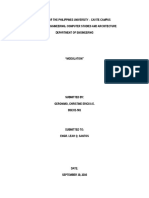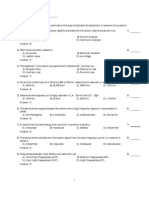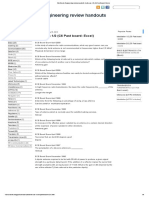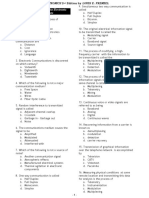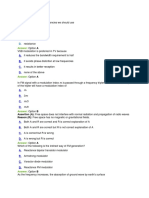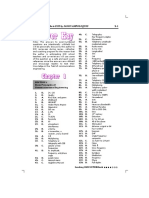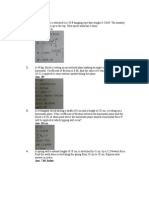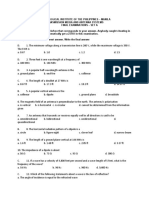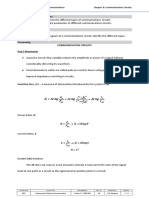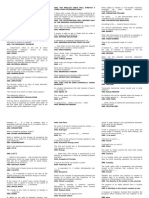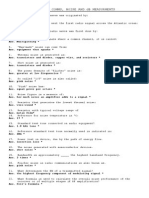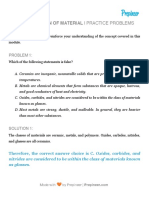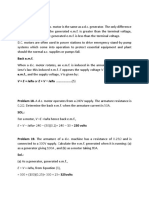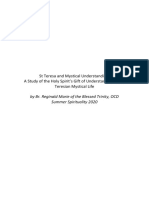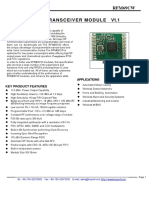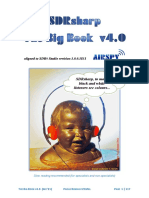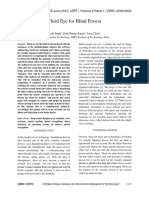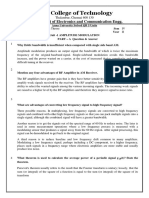Est 3 PDF Free
Uploaded by
kdEst 3 PDF Free
Uploaded by
kdCERTC Bring Home EST
Electronics Engineering
Instruction: Select the correct answer for each of the following with another sine wave at 50% modulation, calculate the total
questions. Mark only one answer for each item by shading the box transmitted power.
corresponding to the letter of your choice on the answer sheet provided. Answer: 12.45 kW
Strictly no erasures allowed. Use pencil no. 1 only. 15. Determine the image frequency for a standard broadcast band
NOTE: Whenever you come across a caret (^) sign, it means receiver using a 455 KHz IF and tuned in a station at 620 kHz.
exponentiation. Answer: 1530 kHz
16. A receiver has a dynamic range of 81 dB. It has 0.55 nW sensitivity.
BASIC COMMUNICATIONS Determine the maximum allowable input signal.
Answer: 0.0692 W
1. An amplifier operating over a 4 MHz bandwidth has a 100 ohm I put
resistance. It is operating at 27 OC, has a voltage gain of 200 and Po
DR=10 log
has an input signal of 5μ Vrms. Determine the rms output voltage Pi
signals.
17. A silicon varactor diode exhibits a capacitance of 200 pF at zero
Answer: 1 mV rms signal, 0.514 mV rms noise bias. If it is in parallel with a 60 pF capacitor and a 200 μH inductor,
2. Determine the noise current for a diode with a forward bias of 1 mA calculate the range of resonant frequency as the diode varies
over a 100 kHz bandwidth and determine also the diode’s through a reverse bias of 3 to 15 V.
equivalent noise voltage. Answer: 966 kHz - 1.15 MHz
Answer: 0.00566 μA rms, 0.147 μV rms C0
3. A three stage amplifier has a 3 dB bandwidth of 200 kHz determined C d=
by an LC tuned circuit at its input and operates at 22 OC. The first
stage has a power gain of 14 dB and a NF of 3 dB. The second and
√ 1+2|V | r
18. Calculate the required Q for the situation having a separation of two
third stages are identical, with power gains of 20 dB and NF=8dB.
sidebands 200 Hz, for a 1 MHz carrier with 80 dB sideband
The output load is 300 ohm, The input noise is generated by a 10 k
suppression and for 100 kHz carrier and 80 dB sideband
ohm resistor. Find noise voltage at the output assuming ideal
suppression.
noiseless amplifiers, overall noise figure, and actual noise voltage at
the output. Answer: 125,000 , 12,500
Answer: 0.311 mV, 3.45 dB, 0.462 mV log −1 (Gain /20 )
4. A satellite system includes a dish antenna (T eq=75K) connected via
a coupling network (Teq=40K) to a microwave receiver (T eq=52K fc
√(¿)
referred to its input). What is the noise power to the receiver’s input 4 ∆f
over a 1 MHz frequency range? Determine the receiver’s NF Q=¿
Answer: 1.75 fW, 0.716 dB
5. An amplifier has an impedance of 50 ohm. Using a matched FREQUENCY MODULATION
impedance diode noise generator, it is found that the DUT has
doubled the noise output power when the diode has a dc current of 19. Determine the bandwidth required to transmit FM signal with a
14 mA. Determine the NR and NF for DUT. maximum deviation of 20 kHz for fi=10 kHz, and 5 kHz.
Answer: 14, 11.46 dB Answer: 80 kHz, 70 kHz
m=2 4 Significant Sidebands
6. A three stage amplifier has an input stage with noise ratio (NR) =5
m=4 7Significant Sidebands
and power gain (PG) = 50. Stages 2 and 3 have NR=10 and P G =
1000. Calculate the NF for the overall system. 20. An FM signal, 2000 sin ( 2 πx 108 t +2 sin ( πx 104 t ) ) to a
Answer: 8.33 dB 50 ohm antenna. Determine
7. Calculate the noise voltage for a 1 k ohm resistor at 17 OC “tuned” by A. Carrier frequency
an LC circuit with a BW of 1 MHz. B. Transmitted power
Answer: 5.01 μV C. mf
8. Calculate the noise voltage for a 1 k ohm resistor at 17 OC of 1 MHz D. fi
frequency range. Repeat for the series and parallel combination of E. BW by Carson’s and Bessel’s Rule
three 1 k ohm resistors. Answer: 100 MHz, 40 kW, 2, 5 kHz, 30 kHz & 40 kHz
Answer: 4 μV, 6.93 μV, 2.31 μV 21. Determine the worst case output S/N for a broadcast FM program
9. Calculate the NF and TEQ for an amplifier that has Zin = 300 ohm. It that has a maximum intelligence frequency of 5 kHz. The input S/N
is found that when driven from a matched-impedance diode noise is 2.
generator, its output noise id doubled when the diode is forward Answer: 30
biased with 0.3 mA. 22. A PLL is set up such that uts VCO free runs at 10 MHz. The VCO
Answer: 2.55 dB, 232 K does not change frequency until the input is within 50 kHz of 10
Mhz. After the condition, the VCO follows the input to + 200 kHz of
AMPLITUDE MODULATION 10 MHz before the VCO starts to free run again. Determine the lock
range and capture range of the PLL
10. A 500 W carrier is to be modulated to 90% level. Determine the total Answer: 100 kHz, 400 kHz
transmitted power.
Answer: 702.5 W WAVE PROPAGATION
11. An AM broadcast station operates of its maximum allowed total
output of 50 kW and at 95% modulation. How much of its 23. Determine the ghost width on a TV screen 15 in wide when a
transmitted power is intelligence sidebands? reflected wave results from an object ½ mi “behind” the receiver.
Answer: 15.5 kW Answer: 1.51 in
12. The antenna current of an AM transmitter is 12 A when unmodulated 24. Calculate the power received at a satellite given the following
but increases to 13 A when modulated, calculate the percent conditions:
modulation. a. Power gain of transmitting parabolic dish antenna is 30,000
Answer: 59% b. The transmitter drives a 2 kW if power into the antenna at a
13. An intelligence signal is amplified by a 70% efficient amplifier before carrier frequency of 6.21 Ghz
being combined with a 10 kw carrier to generate am signal. if it is c. The satellite receiving antenna has a power gain of 30
desired to operate as 100% modulation, what is the dc input power d. The transmission path is 45000 km
to the final intelligence amplifier? Answer: 12.9 pW
Answer: 7.14 kW 25. Calculate the electric field intensity, in volts per meter, 20 km from a
14. A transmitter with 10 kW carrier transmits 11.2 kW when modulated 1 kW source. How many decibels down will that field intensity be an
with a single sine wave. If the carrier is simultaneously modulated additional 30 km from the source?
Answer: 8.66 mV/m, 7.96 dB
RF Review Center : MANILA-CEBU-BAGUIO (0932-175-1218) Page 1
CERTC Bring Home EST
Electronics Engineering
26. Calculate the radio horizon for a 500 ft transmitting antenna and 2
receiving antenna of 20 ft. Calculate the required height increase DR= ( input intercept −noise floor )
for the receiving antenna if 10% increase in radio horizon were 3
required.
FIBER OPTICS
Answer: 37.9 mi, 31.2 ft
27. A transmitter has a power output of 50 W at a carrier frequency of 36. A fiber optic system uses cable with an attenuation of 3.2 dB/km, is
325 MHz. It is connected to an antenna with a gain of 12 dBi. The 1.8 km long, has one splice with 0.8 dB loss, 2 dB loss at both
receiving antenna is 10 km away and has a gain of 12 dBi. The transmitter and receiver due to source/receiver connection, and
receiving ntenna is 10 km away and has a gain of 5 dBi. Calculate requires 3 μW of received optical power at the detector. Calculate
the power delivered to the receiver, assuming free space the required level of optical power from the light source.
propagation. Assume also there are no losses or mismatches in the
system. Answer: 34.1 μW
Answer: 404 nW 37. Calculate the maximum length of a dispersion-limited system where
the fiber has a 0.0015-μs/km dispersion and a 50-Mbps bit rate.
28. A transmitter has a power output of 10 W at a carrier frequency of
250 MHz. It is connected by 10 m of a transmission line having a Answer: 2.67 km
loss of 3 dB/100m to an antenna with a gain of 6 dBi. The receiving 38. Calculate the NA and cutoff wavelength for a single mode fiber with
antenna is 20 km away and has a gain of 4 dBi. There is negligible a core of 2.5μm and refraction indexes of 1.515 and 1.490 for core
loss in the receiver feedline, but the receiver is mismatched: the and cladding, respectively.
antenna and line are designed for a 50 ohm impedance, but the Answer: 0.274, 1.73 μm
receiver input is 75 ohm. Calculate the power delivered to the
receiver assuming free space propagation. 39. Determine the cutoff wavelength for a fiber with a 3 μm diameter
core. The core and cladding indexes of refraction are 1.545 and
Answer: 2.04 nW 1.510, respectively.
29. As a consultant engineer, you need to consider a space-diversity Answer: 1.29 μm
microwave radio system operating at an RF carrier frequency of 1.8
GHz. Each station has a 2.4-m-diameter parabolic antenna that is MICROWAVE
fed by 100 m of air-filled coaxial cable. The terrain is smooth, and
the area has a humid climate. The distance between stations is 40
40. A line of sight radio link operating at a frequency of 6 GHz has a
km. A reliability objective of 99.99% is desired. Determine the
separation of 40 km between antennas. An obstacle in the path is
system gain.
located 10 km from the transmitting antenna. By how much must the
Answer: 113.35 dB beam clear the obstacle
30. A certain antenna has a gain of 7 dB with respect to an isotropic Answer: 11.6 m
radiator. What is the effective area if it operates at 200 MHz? How
41. Calculate the power gain and beamwidth of a microwave dish
much power would it absorb from a signal with a field strength of 50
antenna with a 3 m mouth diameter when used at 10 GHZ.
μV/m?
Answer: 47.8 dB, 0.7O
Answer: 0.897 m2 , 5.95 pW
42. A 160 ft diameter parabolic antenna is driven by a 10 W transmitter
31. A satellite transmitter operates at 4 GHz with an antenna gain of 40
at 4.3 GHz. Calculate its effective radiated power (ERP) and its
dBi. The receiver 40,000 km away has an antenna gain of 50 dBi. If
beamwidth.
the transmitter has a power of 8 W, find the EIRP in dBW and power
delivered to the receiver. Answer: 29.3 MW, 0.10O
Answer: 49 dBW, 178 pW 43. In a microwave system, the antenna sees a sky temperature of
120K and the antenna feedline has a loss of 2 dB. Calculate the
32. A cellular radio transmitter has a power output of 3 W at 800 MHz. It
noise temperature of the antenna/feedline system. Referenced to
uses an antenna with a gain of 3 dBi. The receiver is 45 km away,
the receiver input.
with an antenna gain of 12 dBi. Calculate the received signal
strength in dBm. Ignoring any losses in transmission lines. Answer: 182 K
Answer: -54.7 dBm 44. An AM transmitter has 1 kW carrier and is modulated by three
different sine waves having equal amplitudes. If m eff = 0.8, calculate
COMMUNICATION TECHNIQUES the individual values of m and the total transmitted power.
Answer: 0.464, 1.32 kW
33. An AM broadcast receiver has two identical tuned circuits prior to
the IF stage. The Q of these circuits is 60 and the IF frequency is
ANTENNA
455 kHz and the receiver is tuned to a station at 680 kHz. Calculate
the amount of image frequency rejection.
45. Two λ/2 dipoles are separated by 50 km. They are “aligned” for
Answer: 41 dB
optimum reception. The transmitter feeds its antenna with 10 W at
144 MHz. Calculate the power received
34. A receiver has a 20 dB noise figure (NF), a 1 MHz bandwidth, a +5
Answer: 2.96 x 10-10 W
dBm third order intercept point, and a 0 dB S/N. Determine its
sensitivity and dynamic range. 46. It is designed to build a λ/2 dipole to receive a 100 MHz broadcast.
Determine the optimum length of the dipole.
Answer: -94 dBm , 66 dB
Answer: 1.43 m
S 47. A ship radio telephone transmitter operates at 2738 kHz. At a
Sensitivity=−174 dBm+ NF+10 log ∆ f + certain point distant from the transmitter, the 2738 kHz signal has a
N measured field of 147 mV/m. The second harmonic field at the
2 same point is measured as 405 uV/m to the nearest whole unit in
DR= ( input intercept −noise floor ) decibels, how much has the harmonic emission been attenuated
3 below the 2738 kHz fundamental?
35. A receiver has a 1 MHz bandwidth, a +5 dBm third order intercept Answer: 51.2 dB
point, and a 0 dB S/N. It has a preamplifier out at its input. The
48. If the power of 500 kHz transmitter is increased from 150 W to 300
oreamplifier has a 24 dB gain and a 5 dB NF. Determine its
W, what would be the percentage change in field intensity at a given
sensitivity and dynamic range.
distance from the transmitter? What would be the decibel change in
field intensity?
Answer: -108.5 dBm , 59.7 dB
Answer: 141%, 3 dB
S 49. If a 500 kHz transmitter of constant power produces a field strength
Sensitivity=−174 dBm+ NF+10 log ∆ f + of 100μV/m at a distance of 100 mi from the transmitter, what would
N be the theoretical field strength at a distance of 200 mi from the
NR 2−1 NR 3−1 transmitter?
NR=NR 1+ + +… Answer: 50 μV/m
G1 G1 G2
RF Review Center : MANILA-CEBU-BAGUIO (0932-175-1218) Page 2
CERTC Bring Home EST
Electronics Engineering
50. If the antenna current at a 500 kHz transmitter is reduced 50%, Answer: 105 bits, 104
what would be the percentage change in the field intensity at the
receiving point? 67. Calculate the capacity if a telephone channel that has a S/N 0f 1023
Answer: 50 % Answer: 30 kbps
51. A λ/2 is driven with a 5W signal at 225 Mhz. A receiving dipole 100 68. Calculate the error probability and BER in a system that produces 7
km away is aligned such that its gain is cut in half. Calculate error bits out if 5,700,000 total bits.
received power and voltage into a 73 ohm receiver. Answer: 1.23 x 10-6, 8.14x105
Answer: 7.57 pW, 23.5 μV 69. Calculate the channel capacity (bps) of standard phone line that that
52. The ammeter connected at the base of Marconi antenna has a has a S/N of 511.
certain reading. If the reading increased 2.77 times, what is the Answer: 27 kbps
increased in output power? 70. A telephone line has a bandwidth of 3,2 kHz and a signal to noise
Answer: 7.67 ratio of 35 dB. A signal is transmitted down this line using a four
53. Calculate the efficiency of an antenna that has radiation resistance level doe. What is the maximum theoretical date rate?
of 73 ohm and an effective dissipation resistance of 5 ohm. What Answer: 12.8 kbps
factors could enter into the dissipation resistance? 71. Calculate the CRC for 101001000 if a 1011 divisor is being used
Answer: 93.6 % Answer: 100
54. If vertical antenna is 405 ft high and is operated at 1250 kHz, what 72. Convert the 12 bit sample 100110100100 into an 8 bit compressed
is the physical height expressed in wavelengths? code?
Answer: 5.54 λ Answer: 11011010
55. What must be the height of a vertical radiator one half wavelength 73. Determine the number of bits required to encode a system of 50
high if the operating frequency is 100 kHz? equiprobable events with a binary code. Calculate the efficiency of
Answer: 136 m this code. Calculate the efficiency of a decimal code to accomplish
the same goal.
TRANSMISSION LINE Answer: 94%, 85%
56. A commonly used coaxial, RG-8A/U, has a capacitance of 29.5 pF.ft 74. Calculate the channel capacity (bps) of standard phone line that that
and inductance of 73.75 nH/ft. Determine its characteristic has a S/N of 511.
impedance for a 1 ft section and for a length of 1 mi. Answer: 27 kbps
Answer: 50 ohms, 50 ohms 75. A signal that varies from 20 Hz to 5kHz is to be processed via a
57. Determine the amount of delay and the velocity of propagation pulse modulation scheme. Determine the minimum sampling rate
introduced by a 1 ft section of RG-8A/U coaxial cable used as delay that will still allow adequate reproduction at the receiver. Calculate
line. the number of different time-division-multiplexed signals that could
be transmitted if each sample takes 10 μs.
Answer: 1.475 ns, 2.07 m/s
Answer: 10 kHz, 10
58. Determine the wavelength (λ) of a 100 MHHz signal in free space
and while travelling through an RG-8A/U coaxial cable. 76. We need to send 265 kbps over a noiseless channel with a
bandwidth of 20 kHz. How many signal levels do we need?
Answer: 3 m, 2.07 m
Answer: 98.7
59. A citizen’s band transmitter operating at 27 Mhz with 4 W output is
connected via 10m of RG-8A/U cable to an antenna that has an 77. The signal to noise ratio is often given in decibels. Assume that
input resistance 0f 300 ohms. Determine SNRdB=36 dB and the channel bandwidth is 2 MHz. The theoretical
channel capacity can be calculated as
a. Reflection coefficient
b. Electrical length of cable in wavelength Answer: 24 Mbps
c. VSWR 78. A network with bandwidth of 10 Mbps can pass only an average of
d. The amount if the transmitter 4W output absorbed by the 12000 frames per minute with each frame carrying an average of
antenna 10,000 bits. What is the throughput of this network?
Answer: 0.71, 1,3 λ, 6, 1.96 W Answer: 2 Mbps
60. Find the input impedance and VSWR of a transmission line 4.3λ 79. What are the propagation time and the transmission time for a
long when Z0=100 ohms and ZL=200-j150 ohms. 2.5kbyte message (an e-mail) if the bandwidth of the network is
Answer: 40+j57 ohms, 3.33 1Gbps. Assume that the distance between the sender and the
receiver is 12000 km and that the light travels at 2,4x108 m/s.
61. The antenna load on a 75 ohm line has an impedance of 50-j100
ohms. Determine the length and position of a shirt circuited stub Answer: 50 ms, 20 μs
necessary to provide a match. 80. A signal is carrying data in which one data is encoded as one signal
Answer: 0.083λ length, 0.093λ from the load element (r=1). If the bit rate is 100 kbps, what is the average value
of the baud rate if c is between 0 and 1?
62. If two towers of a 950 kHz antenna are separated by 120 electrical
degrees, what is the tower separation in feet? Answer: 50 kbaud
Answer: 345 ft 81. We want to digitize the human voice. What is the bit rate, assuming
8 bits per sample?
TELEPHONY Answer: 64 kbps
82. We have an available bandwidth of 100 kHz which spans from 200
63. A local loop has a resistance of 1 k ohm, and the telephone to 300 kHz. What should be the carrier frequency and the bit rate if
connected to it has an off hook resistance of 200 ohm. Calculate the we modulated our date by using FSK with d=1?
loop current and the voltage across the telephone when phone is on
hook and off hook. Answer: 25 kbps
Answer: On hook: 0 A, 48 V 83. Four channels are multiplexed using TDM. If each channel sends
Off hook: 40 mA, 8 V 100 bytes and we multiplex 1 byte per channel, show the frame
traveling on the link, the size of the frame, the duration of a frame,
64. What frequencies would be generated by a telephone usind DTMF the frame rate, and the bit rate for the link.
signaling, when number 9 is pressed?
Answer: 4 bytes or 32 bits, 100 frames/second,
Answer: 852 Hz and 1477 Hz 11100 seconds, 100 frames/second, 800 bps
65. A telephone signal takes 2 ms ro reach its destination. Calculate the 84. The bandwidth of a video signal is 4.5 MHz. This signal is to be
via net loss required for an acceptable amount of echo. transmitted using PCM with the number of quantization levels Q =
Answer: 0.8 dB VNL=0.2t+ 0.4 dB 1024. The sampling rate should be 20% higher than the Nyquist
rate. Calculate the system bit rate
DIGITAL AND DATA COMMUNICATIONS Answer: 108 Mbps
-4 9
66. A digital transmission has an error probability if 10 and is 10 bits 85. A multiplexer combines four 100-kbps channels using a time slot of
long. Calculate the expected number if error bits and the BER. 2 bits. Show the output with four arbitrary inputs. What is the frame
RF Review Center : MANILA-CEBU-BAGUIO (0932-175-1218) Page 3
CERTC Bring Home EST
Electronics Engineering
rate? What is the frame duration? What is the bit rate? What is the ANSWER: codewords
bit duration? 103. Which of the following encoding methods does not provide for
Answer: 50, 000 frames/second, 20 μs synchronization?
400 kbps, 2.5 μs ANSWER: NRZ-L
TELEVISION 104. Which encoding method uses alternating positive and negative values
for 1s?
86. A video signal has a 30% of the maximum luminance level. Find its ANSWER: AM
level in IRE units. 105. It is the process of converting digital data to a digital signal.
Answer: 53.75 IRE ANSWER: Line coding
87. Calculate the percentage of the signal time that is occupied by: 106. It provides redundancy to ensure synchronization and inherent error
horizontal blanking, vertical blanking, and active video. detection. It is is normally referred to as mB/nB coding; it replaces
Answer: 15.7%, 8%, 77.6% each m-bit group with an n-bit group.
ANSWER: Block coding
88. An RGB video signal has normalized values of R=0.2, G=0.4,
B=0.8. Find the values of Y, I, Q. 107. It provides synchronization without increasing the number of bits.
ANSWER: Scrambling
Answer: 0.384, -0.248, 0.082
108. In ______ transmission, we send 1 start bit (0) at the beginning and 1 or
Y= 0.30R+0.59G+0.11B I = 0.60R-0.28G-0.32B
more stop bits (1s) at the end of each byte.
Q= 0.21R-0.52G+0.31B
ANSWER: Asynchronous
89. What portion of the maximum transmitter power is used to transmit a
black setup level? 109. In _________ transmission, we send bits one after another without start
or stop bits or gaps. It is the responsibility of the receiver to group the
Answer: 45.6 % bits.
90. Consider a video signal that has a resolution of 640 by 480 pixels; with a ANSWER: Synchronous
30 Hz frame rate and progressive scan. The luminance is sampled using 110. The ________ mode provides synchronization for the entire stream of
8 bits per sample. The two chroma channels also use 8 bits per sample, bits must. In other words, it guarantees that the data arrive at a fixed
but the color resolution is one fourth that used for luminance. Find the rate.
approximate bit rate of this signal, neglecting synchronization, error
correction, and compression. ANSWER: Isochronous
111. A _________ digital signal includes timing information in the data being
Answer: 110.6 Mbps
transmitted.
SATELLITE ANSWER: Self Synchronizing
91. Find the velocity and the orbital period of a satellite in a circular orbit:
500 km and 36,000 km above earth surface. 112. In decoding a digital signal, the receiver calculates a running average of
the received signal power, called the _______.
Answer: 7.6 km/s & 1.6hours, 3.07 km/s &24 hours
ANSWER: baseline
92. Calculate the angle of declination for an antenna using a polar mount at 113. In a _____ scheme, all the signal levels are on one side of the time axis,
a latitude of 45 OC. either above or below.
Answer: 6.81 OC ANSWER: Unipolar
93. Calculate the length of the path of a geostationary satellite from an earth 114. In ______ schemes, the voltages are on the both sides of the time axis.
station were the angle of elevation is 30 O. For example, the voltage level for 0 can be positive and the voltage level
Answer: 39000 km for 1 can be negative.
94. A satellite transmitter operates at 4 GHz with a transmitter power of 7 W ANSWER: Polar
and an antenna gain of 40 dBi. The receiver has antenna gain of 30 dBi, 115. In _____, the level of the voltage determines the value of the bit.
and the path length is 40000 km. Calculate the signal strength at the ANSWER: NRZ-L
receiver. 116. In ______, the change or lack of change in the level of the voltage
Answer: -88 dBm determines the value of the bit.
95. A receiving antenna with gain of 40 dBi looks at a sky with a noise ANSWER: NRZ-I
temperature of 15 K. the loss between the antenna and the LNA input, 117. The idea of RZ and the idea of NRZ-L are combined into the ________
due to feedhorn, is 0.4 dB, and the LNA has a noise temperature of 40 scheme.
K. Calculate G/T. ANSWER: Manchester
Answer: 20.6 dB 118. In _______ encoding, the duration of the bit is divided into two halves.
96. The receiving installation of whose G/T was found in number 95 is used The voltage remains at one level during the first half and moves to the
as a ground terminal to receive a signal from a satellite at a distance of other level in the second half. The transition at the middle of the bit
38,000 km. The satellite has a transmitter power of 50 watts and an provides synchronization.
antenna gain of 30 dBi. Assume losses between the satellite transmitter ANSWER: Both Manchester and Differential Manchester
and its antennas are negligible. The frequency is 12 GHz. Calculate the 119. In ___________ there is always a transition at the middle of the bit, but
carrier to noise ratio at the receiver, for a bandwidth of 1 MHz. the bit values are determined at the beginning of the bit. If the next bit is
Answer: 30.6 dB 0, there is a transition; if the next bit is 1, there is none.
ANSWER: Differential Manchester
DATA & DIGITAL TERMS 120. In Manchester and differential Manchester encoding, the transition at
97. It is a pulse of a direct-sequence spread spectrum (DSSS) code, such the middle of the bit is used for ________
as a Pseudo-random Noise (PN) code sequence used in direct- ANSWER: Synchronization
sequence code division multiple access (CDMA) channel 121. The minimum bandwidth of Manchester and differential Manchester is
access techniques ____ that of NRZ.
Answer: chip ANSWER: twice
98. It is designed to be used in wireless applications in which stations must 122. In _______encoding, we use three levels: positive, zero, and negative.
be able to share the medium without interception by an eavesdropper
and without being subject to jamming from a malicious intruder. ANSWER: bipolar
ANSWER: Spread Spectrum 123. The _____ scheme uses data patterns of size 2 and encodes the 2-bit
patterns as one signal element belonging to a four-level signal.
99. It uses M different carrier frequencies that are modulated by the source
signal. At one moment, the sign modulates one carrier frequency; at the ANSWER: 2B1Q
next moment, the signal modulates another carrier frequency. 124. The ______ scheme uses three levels (+V, 0, and -V) and three
ANSWER: FHSS transition rules to move between the levels.
100. This technique expands the bandwidth of a signal by replacing each ANSWER: MLT-3
data bit with n bits. 125. It substitutes eight consecutive zeros with 000VB0VB.
ANSWER: DSSS ANSWER: B8ZS
101. In block coding, we divide our message into blocks, each of k bits, 126. It substitutes four consecutive zeros with 000V or B00V
called ANSWER: HDB3
ANSWER: datawords 127. A _________ digital signal includes timing information in the data being
102. We add r redundant bits to each block to make the length n = k + r. The transmitted.
resulting n-bit blocks are called _________. ANSWER: Self- synchronizing
RF Review Center : MANILA-CEBU-BAGUIO (0932-175-1218) Page 4
You might also like
- Electronics Exam: Multiple Choice QuestionsNo ratings yetElectronics Exam: Multiple Choice Questions4 pages
- MCQs in Microwave Communications Part IVNo ratings yetMCQs in Microwave Communications Part IV10 pages
- Chapter 1: Introduction To Electronic CommunicationsNo ratings yetChapter 1: Introduction To Electronic Communications33 pages
- Self-Sufficient Guide To ECE by JASON AMPOLOQUIO: Section 1 Basic Principles of Communications EngineeringNo ratings yetSelf-Sufficient Guide To ECE by JASON AMPOLOQUIO: Section 1 Basic Principles of Communications Engineering16 pages
- March 1996 ECE Board Exam - CommunicationsNo ratings yetMarch 1996 ECE Board Exam - Communications3 pages
- RA 9292 Electronics Engineering Law QuizNo ratings yetRA 9292 Electronics Engineering Law Quiz5 pages
- 2.4 EXCEL PB2 OCT2022 EST Highlighted AnswersNo ratings yet2.4 EXCEL PB2 OCT2022 EST Highlighted Answers8 pages
- (Chapter 23) Data-Link Protocols and Data Communications Networks (167 - 177)100% (1)(Chapter 23) Data-Link Protocols and Data Communications Networks (167 - 177)11 pages
- Compilation of Problems by Louis FrenzelNo ratings yetCompilation of Problems by Louis Frenzel5 pages
- Esat MCQS: Section 1: Basic Communications/ Noise/ AM/ FM/ PMNo ratings yetEsat MCQS: Section 1: Basic Communications/ Noise/ AM/ FM/ PM27 pages
- Blue Watercolor Floral Blank Background Document A4 (Landscape)No ratings yetBlue Watercolor Floral Blank Background Document A4 (Landscape)1 page
- Subject: Engineering of Metallurgy: Theoretical Density ComputationsNo ratings yetSubject: Engineering of Metallurgy: Theoretical Density Computations13 pages
- Engineering Management, Ece Laws Contracts Ethics and Safety StandardsNo ratings yetEngineering Management, Ece Laws Contracts Ethics and Safety Standards29 pages
- Classification of Material - Practice Problems: Problem 1No ratings yetClassification of Material - Practice Problems: Problem 112 pages
- ACFrOgBmRBW3G18FRl1Ba6DnciKrMY8UXm7qEvq7sKzrk0elek7DB6-hyWLib4ZRDf1xg2zwNPMhE1Z5KTMdLkDyquP2LGmUoZfZwFstpgHRMfkRfwQFRlD1neH1ZD drq3QFs kgS2Q9iwV7oTfNo ratings yetACFrOgBmRBW3G18FRl1Ba6DnciKrMY8UXm7qEvq7sKzrk0elek7DB6-hyWLib4ZRDf1xg2zwNPMhE1Z5KTMdLkDyquP2LGmUoZfZwFstpgHRMfkRfwQFRlD1neH1ZD drq3QFs kgS2Q9iwV7oTf35 pages
- Diagnostic Ultrasound Instrumentation and OperationNo ratings yetDiagnostic Ultrasound Instrumentation and Operation3 pages
- Microcontroller Based Automatic Toll Collection System (Fauzan - 13115021)No ratings yetMicrocontroller Based Automatic Toll Collection System (Fauzan - 13115021)16 pages
- Microwave Radio Propagation: Technical Center Group NEC IndiaNo ratings yetMicrowave Radio Propagation: Technical Center Group NEC India17 pages
- TM 11-6625-928-12 - Test - Faclilities - Kit - MK-994 - 1968 PDFNo ratings yetTM 11-6625-928-12 - Test - Faclilities - Kit - MK-994 - 1968 PDF58 pages
- Testo 435 Multifunction Instrument ManualNo ratings yetTesto 435 Multifunction Instrument Manual36 pages
- Agni College of Technology Agni College of Technology Agni College of TechnologyNo ratings yetAgni College of Technology Agni College of Technology Agni College of Technology19 pages
- User's Manual: Programmable Room Thermostat With RF (Volt Free) Model 091FLRFNo ratings yetUser's Manual: Programmable Room Thermostat With RF (Volt Free) Model 091FLRF30 pages
- RRU5304w Technical Specifications (V100R017C00 - 01) (PDF) - ENNo ratings yetRRU5304w Technical Specifications (V100R017C00 - 01) (PDF) - EN22 pages



